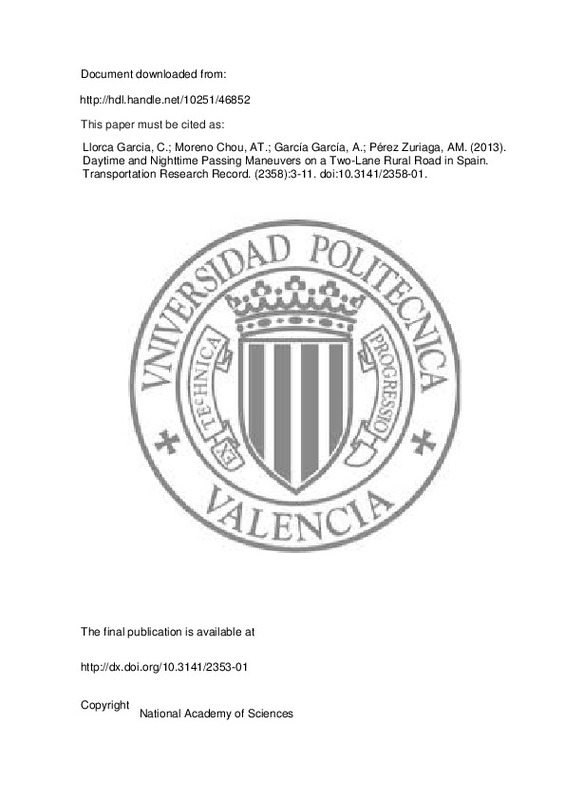JavaScript is disabled for your browser. Some features of this site may not work without it.
Buscar en RiuNet
Listar
Mi cuenta
Estadísticas
Ayuda RiuNet
Admin. UPV
Daytime and Nighttime Passing Maneuvers on a Two-Lane Rural Road in Spain
Mostrar el registro sencillo del ítem
Ficheros en el ítem
| dc.contributor.author | Llorca García, Carlos
|
es_ES |
| dc.contributor.author | Moreno Chou, Ana Tsui
|
es_ES |
| dc.contributor.author | García García, Alfredo
|
es_ES |
| dc.contributor.author | Pérez Zuriaga, Ana María
|
es_ES |
| dc.date.accessioned | 2015-02-09T12:51:22Z | |
| dc.date.available | 2015-02-09T12:51:22Z | |
| dc.date.issued | 2013 | |
| dc.identifier.issn | 0361-1981 | |
| dc.identifier.uri | http://hdl.handle.net/10251/46852 | |
| dc.description.abstract | [EN] Passing is one of the most complex driving maneuvers performed on two-lane rural roads and has important effects on road safety and traffic operation. Passing is affected by driving behavior, road geometry, traffic volume, and traffic composition as well as external factors. Research was developed to compare the passing process under daytime and nighttime conditions. An experimental method was designed to collect video data of passing maneuvers on a two-lane rural road segment located near Valencia, Spain. Two methods were used: (a) external observations of four passing zones with six video cameras and (b) an instrumented vehicle equipped with video cameras and laser rangefinders, driven slightly below the operating speed along a segment of the same road so it would be passed by other vehicles. A total of 291 maneuvers were observed, up to 20% of which were at night. Macroscopic analysis results indicated that approximately 17% of passes were at night, even though passing frequency and passing demand decreased at night. Also, the behaviors of individual drivers who passed other vehicles were different at night and during the day. Maneuvers limited by the presence of an opposing vehicle were performed more quickly at night, even if the accepted gaps were longer. In this case, a more difficult perception of distances to opposing vehicles and of vehicle speeds explained the differences. In contrast, maneuvers limited by sight distance (without a visible opposing vehicle) were slower at night. This observation matched a traditional hypothesis: passing at night is safer because the headlights of an opposing vehicle allow a driver to anticipate the vehicle's position before it becomes visible. | es_ES |
| dc.description.sponsorship | The authors thank the Spanish Ministry of Economy and Competitiveness for subsidizing the research project as well as the Spanish Ministry of Public Works and the Spanish General Traffic Directorate for collaboration during the field study. | |
| dc.language | Inglés | es_ES |
| dc.publisher | National Academy of Sciences | es_ES |
| dc.relation.ispartof | Transportation Research Record | es_ES |
| dc.rights | Reserva de todos los derechos | es_ES |
| dc.subject.classification | INGENIERIA E INFRAESTRUCTURA DE LOS TRANSPORTES | es_ES |
| dc.title | Daytime and Nighttime Passing Maneuvers on a Two-Lane Rural Road in Spain | es_ES |
| dc.type | Artículo | es_ES |
| dc.identifier.doi | 10.3141/2358-01 | |
| dc.rights.accessRights | Abierto | es_ES |
| dc.contributor.affiliation | Universitat Politècnica de València. Instituto del Transporte y Territorio - Institut del Transport i Territori | es_ES |
| dc.contributor.affiliation | Universitat Politècnica de València. Departamento de Ingeniería e Infraestructura de los Transportes - Departament d'Enginyeria i Infraestructura dels Transports | es_ES |
| dc.description.bibliographicCitation | Llorca Garcia, C.; Moreno Chou, AT.; García García, A.; Pérez Zuriaga, AM. (2013). Daytime and Nighttime Passing Maneuvers on a Two-Lane Rural Road in Spain. Transportation Research Record. (2358):3-11. doi:10.3141/2358-01 | es_ES |
| dc.description.accrualMethod | S | es_ES |
| dc.relation.publisherversion | http://dx.doi.org/10.3141/2353-01 | es_ES |
| dc.description.upvformatpinicio | 3 | es_ES |
| dc.description.upvformatpfin | 11 | es_ES |
| dc.type.version | info:eu-repo/semantics/publishedVersion | es_ES |
| dc.description.issue | 2358 | es_ES |
| dc.relation.senia | 251735 | |
| dc.contributor.funder | Ministerio de Economía y Competitividad | es_ES |







![[Cerrado]](/themes/UPV/images/candado.png)

